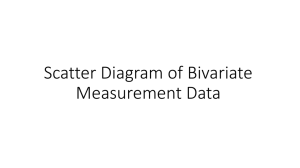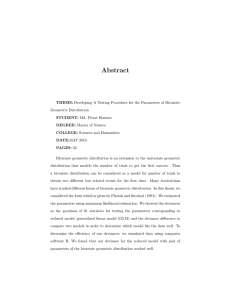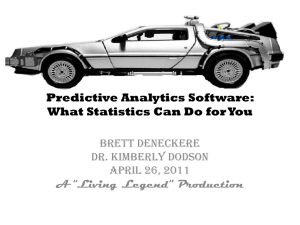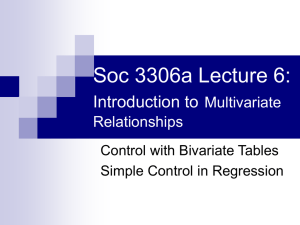– Spectral Analysis of ST414 Time Series Data Lecture 5
advertisement
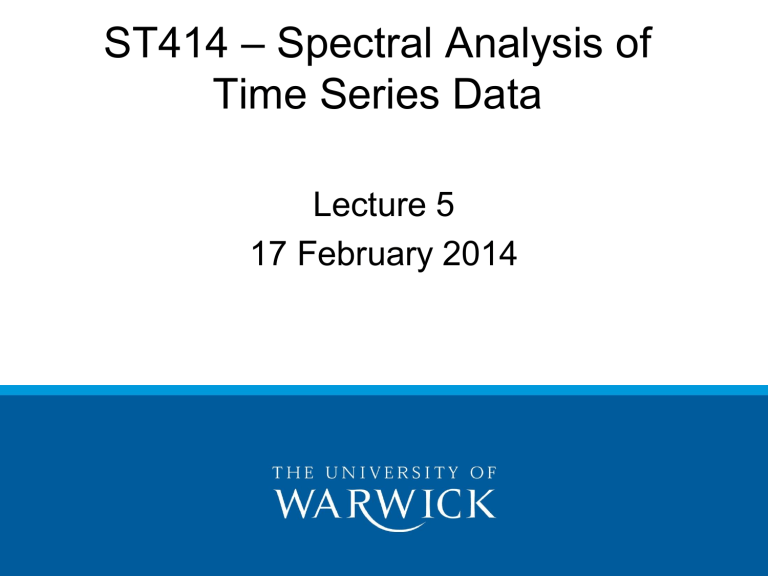
ST414 – Spectral Analysis of
Time Series Data
Lecture 5
17 February 2014
Last Time
• Estimating the AR parameters
– Yule-Walker Equations
– Conditional MLE
• The AR spectrum
2
Today’s Objectives
•
•
•
•
Introduction to bivariate processes
The cross-covariance function
The cross-spectrum
Coherence analysis
3
Bivariate Time Series
4
Bivariate Time Series
5
Preliminaries
The cross-covariance function between
X(t) and Y(t) is
𝛾𝑋𝑌 𝑠, 𝑡 = 𝐶𝑜𝑣(𝑋 𝑠 , 𝑌 𝑡 )
The cross-correlation function between
X(t) and Y(t) is
𝛾𝑋𝑌 𝑠, 𝑡
𝜌𝑋𝑌 𝑠, 𝑡 =
𝛾𝑋 𝑠, 𝑠 𝛾𝑌 𝑡, 𝑡
6
Preliminaries
The bivariate time series (X(t),Y(t))T is
weakly stationary if each of X(t) and Y(t)
are weakly stationary and the crosscovariance function depends on only the lag,
i.e., 𝛾𝑋𝑌 𝑠, 𝑡 = 𝛾𝑋𝑌 ( 𝑠 − 𝑡 ). Note that
𝛾𝑋𝑌 ℎ = 𝛾𝑌𝑋 (−ℎ).
7
Preliminaries
The covariance matrix of a weakly
stationary bivariate time series (X(t),Y(t))T is
𝛾𝑋 ℎ
Γ(ℎ) =
𝛾𝑌𝑋 ℎ
𝛾𝑋𝑌 ℎ
𝛾𝑌 ℎ
8
Example
9
Bivariate White Noise
Z(t) is a bivariate white noise process (0,Σ) if
it has mean the zero vector and 2x2
covariance matrix 𝑍 𝑡 𝑍 𝑡 ′ = Σ (assumed to
be nonsingular) and 𝑍 𝑡 𝑍 𝑠 ′ = 0 for s ≠ 𝑡.
10
The VAR(p) process
The VAR(p) model for a bivariate time series
X(t) is
𝑝
𝑋 𝑡 =
Φ𝑘 𝑋(𝑡 − 𝑘) + 𝑍 𝑡 ,
𝑘=1
where the Φ𝑘′ s are 2x2 fixed matrices and
Z(t) is bivariate white noise.
11
Preliminaries
A bivariate process X(t) is a linear process
if it has the representation
∞
𝑿 𝑡 =
𝑪𝑗 𝒁(𝑡 − 𝑗),
𝑗=−∞
for all t, where Z(t) is bivariate white noise
and {𝑪𝑗 } is a sequence of matrices whose
components are absolutely summable.
12
Example
Let X(t) be weakly stationary with
autocovariance function 𝛾𝑋 (ℎ), and suppose
𝑌 𝑡 = 𝐴𝑋 𝑡 − 𝑙 + 𝑍(𝑡), where Z(t) is white
noise (0, 𝜎 2 ) independent of X(t). What is
𝛾𝑌 ℎ and 𝛾𝑌𝑋 ℎ ?
𝛾𝑌 ℎ = 𝐴2 𝛾𝑋 ℎ + 𝛾𝑍 (ℎ)
𝛾𝑌𝑋 ℎ = 𝐴𝛾𝑋 (ℎ − 𝑙)
13
The Cross-spectrum
Let 𝛾𝑋𝑌 (ℎ) be the (absolutely summable) crosscovariance function between X(t) and Y(t).
Then the cross-spectrum is
𝑓𝑋𝑌 𝜔 =
𝛾𝑋𝑌 ℎ exp −𝑖2𝜋𝜔ℎ
ℎ𝜖𝒁
Moreover,
0.5
𝛾𝑋𝑌 ℎ =
𝑓𝑋𝑌 𝜔 exp 𝑖2𝜋𝜔ℎ 𝑑𝜔
−0.5
14
The Spectral Density Matrix
The spectral density matrix of a bivariate
process (X(t),Y(t))T is
𝑓𝑋 𝜔
𝒇(𝜔) =
𝑓𝑌𝑋 𝜔
𝑓𝑋𝑌 𝜔
𝑓𝑌 𝜔
Note that 𝑓𝑋𝑌 𝜔 = 𝑓𝑌𝑋 𝜔 .
15
The Spectral Density Matrix
If each element of Γ(ℎ) is absolutely
summable, then
𝒇 𝜔 =
Γ(ℎ) exp(−𝑖2𝜋𝜔ℎ)
ℎ𝜖𝒁
and
1/2
Γ ℎ =
exp 𝑖2𝜋𝜔ℎ 𝒇 𝜔 𝑑𝜔
−1/2
16
Coherence
The squared coherence between X(t) and
Y(t) is
2
|𝑓
𝜔
|
𝑋𝑌
2
𝜌𝑋𝑌 𝜔 =
𝑓𝑋 𝜔 𝑓𝑌 𝜔
17
Example
Let X(t) be weakly stationary with
autocovariance function 𝛾𝑋 (ℎ), and suppose
𝑌 𝑡 = 𝐴𝑋 𝑡 − 𝑙 + 𝑍(𝑡), with Z(t)
independent of X(t). What is 𝑓𝑌𝑋 𝜔 ? What
2
is 𝜌𝑌𝑋
𝜔 ?
18
Example
Let 𝑋1 𝑡 ~𝐴𝑅 1 with AR coefficient 0.9, and
let 𝑋2 𝑡 ~𝐴𝑅 1 with AR coefficient -0.9, and
𝑋1 𝑡 ⊥ 𝑋2 𝑡 .
For a scalar 𝑊 with 0 ≤ 𝑊 ≤ 1, define
𝑌1 𝑡
𝑊𝑋1 𝑡 + 1 − 𝑊 𝑋2 𝑡
=
𝑌2 𝑡
𝑋1 𝑡
How does the squared coherence between
𝑌1 𝑡 and 𝑌2 𝑡 as a function of frequency 19
behave with respect to 𝑊?
Example
20
Example
Let 𝑋1 𝑡 ~𝐴𝑅 1 with AR coefficient 0.9, and
let 𝑋2 𝑡 ~𝐴𝑅 1 with AR coefficient -0.9, and
𝑋1 𝑡 ⊥ 𝑋2 𝑡 .
For a scalar 𝑊 with 0 ≤ 𝑊 ≤ 1, define
𝑌1 𝑡
𝑊𝑋1 𝑡 + 1 − 𝑊 𝑋2 𝑡
=
𝑌2 𝑡
0.5𝑋1 𝑡 + 0.5𝑋2 𝑡
How does the squared coherence between
𝑌1 𝑡 and 𝑌2 𝑡 as a function of frequency 21
behave with respect to 𝑊?
Example
22
Nonparametric Estimation
Given a bivariate time series (𝑋1 t , 𝑋2 t )′,
construct the bivariate DFTs 𝑑 𝜔𝑗 =
(𝑑𝑋1 𝜔 , 𝑑𝑋2 𝜔 )′, where
𝑇
𝑑𝑋𝑗 𝜔𝑗 = 𝑇 −1/2
𝑋𝑗 𝑡 exp(−𝑖2𝜋𝜔𝑗 𝑡)
𝑡=1
23
Nonparametric Estimation
The periodogram matrix is
𝑰 𝜔𝑗 = 𝑑 𝜔𝑗 𝑑 𝜔𝑗
∗
24
Nonparametric Estimation
The smoothed periodogram matrix is
𝒇 𝜔𝑗
1
=
2𝑀 + 1
𝑀
𝑘=−𝑀
𝑘
𝑰(𝜔𝑗 + )
𝑇
25
Nonparametric Estimation
More generally,
𝑀
𝒇 𝜔𝑗 =
𝑘=−𝑀
where
ℎ𝑘 ≥ 0,
|𝑘|≤𝑀 ℎ𝑘
𝑘
ℎ𝑘 𝑰(𝜔𝑗 + )
𝑇
= 1, and ℎ𝑘 = ℎ−𝑘
26
Nonparametric Estimation
From here, an estimate of the squared
coherence is
2
𝜌𝑋𝑌
𝜔 =
|𝑓𝑋𝑌 𝜔 |2
𝑓𝑋 𝜔 𝑓𝑌 𝜔
27
Nonparametric Estimation
Let Z(t) be bivariate Gaussian white noise
(0, Σ), Σ non-singular, and let 𝑰(𝜔) be the
periodogram matrix of Z(t). Then as 𝑇 → ∞,
𝑰(𝜔) converges in distribution to a random
matrix 𝑌𝑌 ∗ , where 𝑌~𝑁 𝐶 (0, Σ).
28
Nonparametric Estimation
𝐸 𝒇 𝜔
𝐶𝑜𝑣 𝑓𝑝𝑞 𝜔 , 𝑓𝑟𝑠 𝜆
2
𝑀
ℎ
𝑘=−𝑀 𝑘
→ 𝑓
𝑝𝑟
→𝒇 𝜔
0 if 𝜔 ≠ 𝜆
𝜔 𝑓𝑠𝑞 𝜔 if 𝜔 = 𝜆 ≠ 0, 0.5
29
Nonparametric Estimation
|𝜌𝑋𝑌 𝜔 |
2
𝑀
ℎ
𝑘=−𝑀 𝑘
~𝐴𝑁( 𝜌𝑋𝑌 𝜔 , 1 − 𝜌𝑋𝑌 𝜔
𝑡𝑎𝑛ℎ−1 ( 𝜌𝑋𝑌 𝜔 )
2
𝑀
ℎ
𝑘=−𝑀 𝑘
2
/2)
~𝐴𝑁(𝑡𝑎𝑛ℎ−1 ( 𝜌𝑋𝑌 𝜔 ), 1/2)
30
Nonparametric Estimation
Alternatively, if we use a uniform kernel for
2
smoothing, under 𝐻0 : 𝜌𝑋𝑌
𝜔 = 0, we have
2
𝜌𝑋𝑌
𝜔
𝐹=
2𝑀
2
1 − 𝜌𝑋𝑌
𝜔
𝐹~𝐹(2, 2 2𝑀 + 1 − 2)
31
Example
32
Example
33
Example
34
Example
35
Example
36
Example
37
Example
38
Example
39
Example
40
Example
−2.682 ∙ 2𝜋
−4.173 ∙ 2𝜋
41
